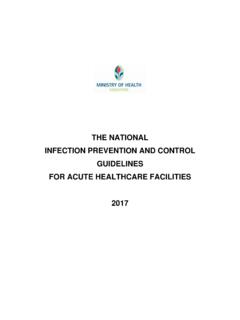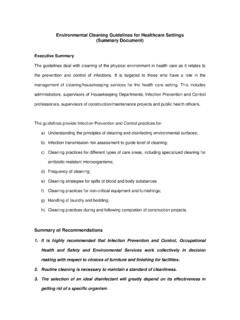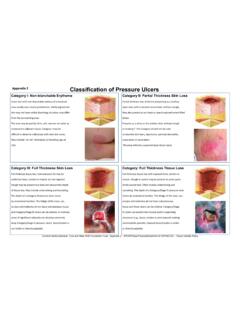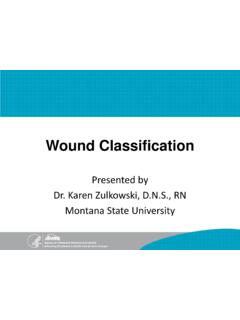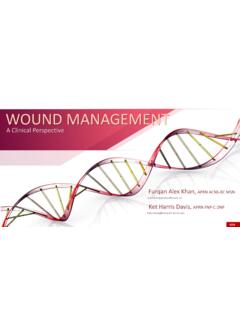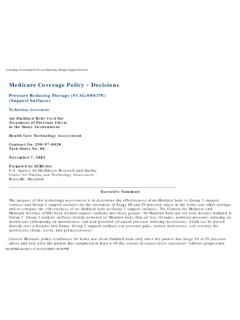Transcription of Nursing Management of Pressure Ulcers in Adults
1 31 Dec 2001 MOH Nursing CLINICAL PRACTICE GUIDELINES 2/2001 NursingManagementof Pressure Ulcersin Adults29 NursingManagementof Pressure Ulcersin AdultsMOH Nursing CLINICAL PRACTICE GUIDELINES 2/2001 Dec 200132 STATEMENT OF INTENTThis set of guidelines serves as a guide for caregivers of Adults with pressureulcers. It should be used in conjunction with MOH Nursing Clinical PracticeGuidelines 1/2001 Prediction and Prevention of Pressure Ulcers in are based on best available evidences at the time ofguideline development. New research studies are ongoing thus the contentsare subject to updates as scientific knowledge unfolds. Due to the uniquevariations in each individual circumstance, adopting this set of guidelinesdoes not guarantee effective client outcomes in every practitioner must exercise clinical judgement in the Nursing managementof patients with Pressure Ulcers . Practitioners must assess theappropriateness of the recommendations in the light of individual client scondition, overall treatment goal, resource availability, institutional policiesand viable treatment options before adopting any of them for their prevention and treatment of Pressure Ulcers is a challenge in thecare of patients with compromised mobility.
2 Prediction through accurateassessment and prevention of Pressure Ulcers using appropriatemeasures are of primary importance. However, for patients who havealready developed Pressure Ulcers , timely intervention can reducemorbidity and mortality rates. The concerted effort of patients,caregivers, nurses, doctors, dietitians and other paramedical personnelis necessary for optimal am pleased to present these clinical practice guidelines as a followup to the Nursing Clinical Practice Guidelines on the Prediction andPrevention of Pressure Ulcers in Adults . The main aims of theseguidelines are to enhance appropriateness, effectiveness and efficiencyof care, and to reduce unacceptable variation in clinical practice. I hopethat these guidelines will be incorporated into the routine nursingpractice in our institutions, for the benefit of our TAN CHORH CHUANDIRECTOR OF MEDICAL SERVICES35 CONTENTS1 Introduction .. Background.
3 Definition of Pressure Ulcers .. Staging of Pressure Ulcers .. Highlights of Patient Management .. Scope of the Guidelines .. 92 Development of Training and Guidance .. Strategy and Literature Review .. Evaluation of Evidence and Grading of Recommendations .. Guidelines Review and Limitations .. 143 Algorithm for the Nursing Management of Pressure Ulcersin Adults .. 154 Clinical Guidelines/ Recommendations .. Assessment .. Wound Debridement .. Dressings .. Nutrition .. Psychosocial Assessment .. Pain .. 245 Clinical Audit .. Outcome Indicators .. Management Role .. 256 Implementation of Guidelines .. 26 References .. 27 Glossary .. 29 Workgroup Members .. Ulcers remain a serious problem in the care of vulnerablepatients. According to a local study by the Ministry of Health (MOHN ursing Department 1998), the incidence ranges from 5% 16%among in-patients.
4 Prevention is better than cure. However, if patientshave Pressure Ulcers , accurate assessment followed by prompt andeffective Management can minimise pain and other of Pressure UlcersA Pressure ulcer is defined as an area of localised damage to the skin,muscle and/or underlying tissue, caused by shear, friction or unrelievedpressure, usually over bony prominences . of Pressure UlcersThe staging of Pressure Ulcers uses the National Pressure UlcersAdvisory Panel four-level staging system (NPUAP 1989; NPUAP 1998). stage I: An observable Pressure related alteration of intact skinwhose indicators as compared to the adjacent or oppositearea on the body may include changes in one or more ofthe following: skin temperature (warmth or coolness) tissue consistency (firm or boggy feel) and/or sensation (pain, itching).The ulcer appears as a defined area of persistent rednessin lightly pigmented skin, whereas in darker skin tones, theulcer may appear with persistent red, blue, or purple II: Partial thickness skin loss involving epidermis, dermis, orboth.
5 The ulcer is superficial and presents clinically as anabrasion, blister, or shallow III: Full thickness skin loss involving damage to or necrosis ofsubcutaneous tissue that may extend down to, but notthrough, underlying fascia. The ulcer presents clinically asa deep crater with or without sinus tracts extending intoadjacent IV: Full thickness skin loss with extensive destruction, tissuenecrosis, or damage to muscle, bone, or supportingstructures ( tendon, joint capsule). Sinus tracts alsomay be associated with stage IV Pressure staging definitions recognise the following limitations: stage I Pressure Ulcers may be superficial, or they may be a sign ofdeeper tissue damage; stage I Pressure Ulcers are not always accurately assessed, especiallyin patients with darkly pigmented skin; When an eschar is present, a Pressure ulcer cannot be accurately stageduntil it is removed; It may be difficult to assess Pressure Ulcers in patients with casts, otherorthopaedic devices, or support stockings.
6 Extra vigilance is required toassess Ulcers under these IEpidermis (redness) stage IIDermis stage IIIS ubcutaneous stage IVMuscle Figure 1 Diagrammatic presentation of Pressure ulcer at various of Patient ManagementPatients and their families are important team players in the effectivemanagement of Pressure ulcer treatment. The clinician should: Discuss treatment options with patients and their families Encourage patients to be active participants in their care Develop an effective plan of care that is consistent with the patient sgoalsThe recommended treatment programme should focus on: Assessment of the patient and the Pressure ulcer (s) Managing tissue loads ulcer care Managing bacterial colonisation and infection Operative repair of the Pressure ulcer (s) Education and quality of the GuidelinesThese clinical practice guidelines are tools for assisting clinical decisionmaking about the Nursing care given to patients with Pressure are the result of systematic identification and synthesis ofpublished research findings and expert opinion.
7 They should beadapted locally to suit a particular situation and patient. It is the intentionof the workgroup not to be encyclopaedic in coverage but to producea concise, readable and practical format that addresses key topicswhich can be used as a reference and training set of guidelines is intended as a simple and readable referencefor caregivers of Adults with Pressure OF and GuidanceMembers of the workgroup attended a two-day interactive trainingworkshop to learn about and discuss the theory and practical issuesof developing evidence-based guidelines under the guidance ofDr Edwin Chan and Dr Miny Samuel of the MOH Clinical Trials &Epidemiology Research Unit. The practical training revolved aroundtopic selection and the development of mock evidence-basedguidelines which developed into this present and Literature ReviewTwo highly regarded evidence-based guidelines were reviewed: The Agency of Healthcare Research and Quality (AHRQ) PracticeGuideline on Pressure ulcer Treatment: Technical Report Number15 Treating Pressure Ulcers Volume 1 (Bergstrom and Cuddigan1994); and The Pressure Sores Part II: Management of Pressure RelatedTissue Damage from The Joanna Briggs Institute for EvidenceBased Nursing & Midwifery (JBI 1997).
8 The members felt that an updated literature search on the specifictopics addressed would suffice. The electronic databases (MEDLINE,EMBASE, Cochrane Library, SPRINGNET and CINAHL) and hard copiesof relevant journals (Journal of Wound Care, Advances in Wound Care,Current Problems in Surgery, Resources in Wound Care ManagementDirectory) were of Evidence and Grading of RecommendationsWe adopted the revised Scottish Intercollegiate Guidelines Network(SIGN 2001) procedure which gives clear guidance on evaluating thedesign of individual studies, grading each study s level of evidence(see and ); and assigning a grade to the recommendationafter taking into account external validity, result consistency, localconstraints and expert opinion (see ). The extensive reliance onthe AHRQ and JBI guidelines is acknowledged and treated as a veryspecial case of published expert guideline statement with the accompanying rationale was modelledafter the simple declarative style of the Dialysis Outcomes QualityInitiative guidelines (NKF-K/DOQI 2001) in order to provide a clear linkbetween the recommendation and its justification.
9 The word should is not to be taken to mean must . Individual Study Validity RatingAll primary studies and reviews addressing a particular topic of wound size, were appraised using a SIGN checklistappropriate to the study s design. This resulted in an individual studyrating for internal validity according to the criteria described below:Rating Description++All or most of the criteria have been fulfilled. Where theyhave not been fulfilled the conclusions of the study orreview are thought very unlikely to alter.+Some of the criteria have been fulfilled. Those criteria thathave not been fulfilled or not adequately described arethought unlikely to alter the conclusions. Few or no criteria fulfilled. The conclusions of the studyare thought likely or very likely to Levels of EvidenceThe study design is designated by a numerical prefix 1 for systematic reviews or meta-analyses or randomisedcontrolled trials (RCTs) 2 for cohort and case-control studies 3 for case reports/series 4 for expert opinion/ logical arguments/ common sense7 Each study is assigned a level of evidence by combining the designdesignation (1, 2, 3 or 4) and its validity rating (++, + or -).
10 The meaningof the various levels of evidence are given below:Level Type of Evidence1++High quality meta-analyses, systematic reviews of RCTs,or RCTs with a very low risk of +Well-conducted meta-analyses, systematic reviews, orRCTs with a low risk of , systematic reviews, or RCTs with a highrisk of ++High quality systematic reviews of case-control or quality case-control or cohort studies with a very lowrisk of confounding or bias and a high probability that therelationship is +Well-conducted case-control or cohort studies with a lowrisk of confounding or bias and a moderate probabilitythat the relationship is or cohort studies with a high risk ofconfounding or bias and a significant risk that therelationship is not studies case reports, case Grade of RecommendationThe detailed results of each study and mitigating local circumstanceswere considered in the formulation of each guideline which was thenassigned a grade of recommendation according to the criteria listedbelow.

